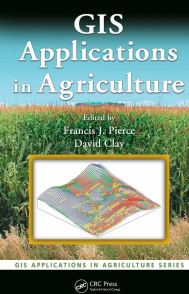Preface of the Book
Agriculture is a business sector ideally suited for the application of Geographic Information Systems (GIS) because it is natural resource based, requires the movement, distribution, and/or utilization of large quantities of products, goods, and services, and is increasingly required to record details of its business operations from the field to the marketplace.
Nearly all agricultural data has some form of spatial component, and a GIS allows you to visualize information that might otherwise be difficult to interpret. The value of GIS to agriculture continually increases as advances in technology accelerate the need and opportunities for the acquisition, management, and analysis of spatial data on the farm and throughout the agriculture value chain.
As a technology, GIS has greatly advanced from its initial use in the 1960s by cartographers who wanted to adopt computer techniques in map-making to the versatile toolkit it is today.
The GIS toolkit available today has evolved largely by innovations created in one application of GIS being shared and built upon in subsequent applications. Thus, GIS users, by sharing their innovations and applications formally and informally, were very important to the development of the GIS tools available today. Sharing applications and innovations among users remains an important aspect of GIS both within and across disciplines and business sectors.
The GIS toolkit available today has evolved largely by innovations created in one application of GIS being shared and built upon in subsequent applications. Thus, GIS users, by sharing their innovations and applications formally and informally, were very important to the development of the GIS tools available today. Sharing applications and innovations among users remains an important aspect of GIS both within and across disciplines and business sectors.
Those who use GIS in agriculture recognize that the potential application of GIS in agriculture is large. However, the GIS user community in production agriculture is rather small compared to other business sectors. There is a lack of formal opportunities to share applications and innovations of GIS specifically focused on agriculture.
To support and advance the use of GIS in agriculture, our intent was to develop a book series to provide a venue for users to share their applications and innovations of GIS in agriculture.
To support and advance the use of GIS in agriculture, our intent was to develop a book series to provide a venue for users to share their applications and innovations of GIS in agriculture.
The book series is titled GIS Applications for Agriculture and will be published and distributed by CRC Press. Books in this series will be published periodically as need and resources allow. The primary audience for this book series is current users of GIS in an agricultural context including researchers, educators, government agencies, private firms, consultants, and growers. The intent is for the infusion of these agricultural applications into standard GIS publications and formal and informal education programs within and external to agriculture.
This book is the first in a proposed series of books focusing on relevant applications of GIS for agriculture that will address a range of topics and audiences. It includes 10 chapters with an accompanying CD that provide examples of GIS applications primarily associated with precision agriculture, with one (Chapter 1) dealing with a regional water quality problem. Most chapters provide data and software programs that enable readers to recreate the specific application as part of a formal or informal learning experience in GIS. Ideas for future volumes in the GIS Applications for Agriculture series are welcome.
Download Here




No comments:
Post a Comment